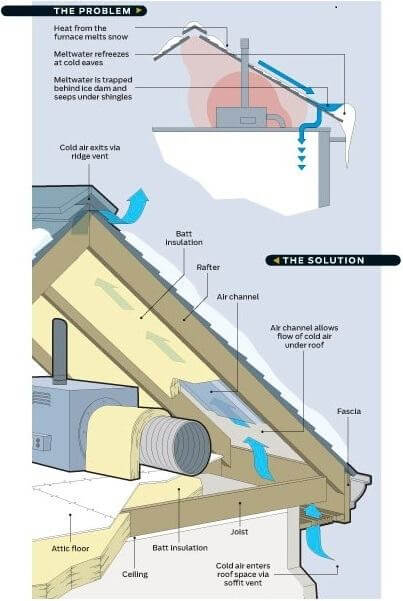An Ice Dam is a ridge of ice that forms at the edge of a roof and prevents water caused by melting snow from draining off the roof. Once water backs up behind the dam, it can leak into a home and cause damage to walls, ceilings, insulation and other areas.
Ice dams can be prevented by controlling the heat loss from your home. If you have already spotted ice dams on your roof, you’ll want to act quickly. Learn what to do when it’s too late to prevent ice dams.
Prevent Water Damage When Snow Melts
Roofs, yards, and roads across throughout the state are packed with snow right now. The piles in the Twin Cities are deep. This means it’s important to consider now what will happen once the snow starts to melt.
Roof snow melts in February either because the sun is warm or, more commonly, because the attic is improperly insulated.
Here is a 3-step, long-term strategy to keep water from damaging your home:
You want your roof to remain cold. Don’t heat it. Maintaining low temperatures is accomplished by ensuring adequate insulation and sealing gaps to let warm air pass into the attic from the house.
Make sure your attic is well-ventilated, especially in those spots where cold air is introduced into the attic and heated air escapes rapidly. Remember, though, that there should not be any air leakage from the house into the attic space.
If gable and ridge vents do NOT generate sufficient air movement to dissipate heat, you will want to install a motorized vent at one end of the attic. This will exhaust the heat. You’ll also need right-sized vent to draw cold air in.
Extra Attention is Required
Recessed lights, skylights, complicated roof designs and heating ducts in attics will all increase the risk of ice dam formation. This, of course, means that you must be diligent to check your roof on a regular basis.
Green Clean offers the following services that may interest you:
Resources to Protect Your Investment in Your Home
Centerpoint Energy’s Standard Energy Audit can help you determine where heat is being lost, which is part of the course of action to prevent ice dams. Centerpoint offers $100 Rebate certificates to offset the cost of this service.
Need an Attic Seal-up? Call Craig Edwards over at Quality Insulation.
Call Green Clean any time to ask questions, or learn more here about our water damage restoration solutions!
Prev: What to Do When It’s Too Late to Prevent Ice DamsNext: Does Empowered Water™ Really Work Better for Cleaning Carpet?View All Resources